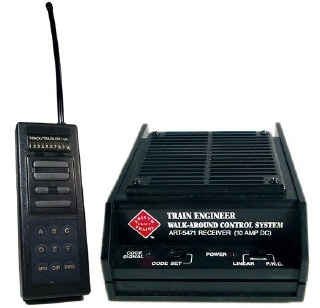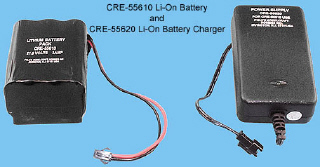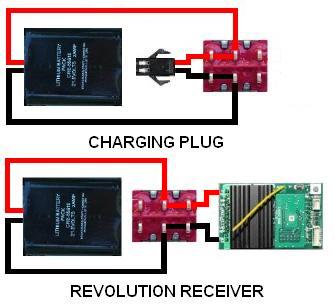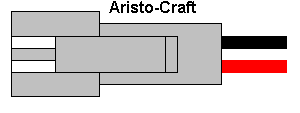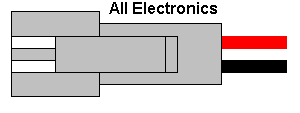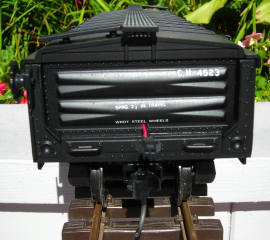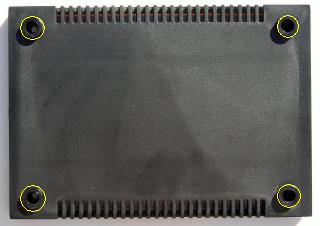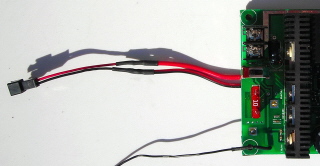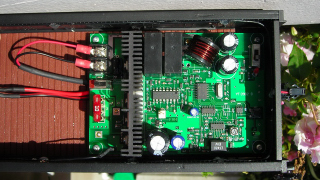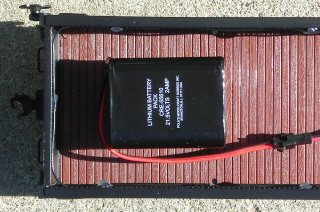Aristo-Craft, Plug and Play diesels are sold with MU connectors on each end, and a switch to change between track power and battery power. This project details how to build a power and control car to take advantage of those connectors. A power and control car is simply a battery car with a receiver added for on-board radio control.
Boxcars, stockcars, and B units can be used for power and control cars; but the cheapest and most practical is the covered gondola. Removing the snap on cover allows easy access to the receiver for programming and removal of the battery for charging. Replacing the cover hides the components and protects them from the elements. The ends of the gondola can also be folded down inside the car should extra cooling be required for the receiver.
For this power and control car an Aristo-Craft Lithium-Ion battery and 27 MHz trackside receiver were used.
A Revolution receiver could be used instead, but a Double-Pole, Double-Throw center-off switch would have to be installed to turn the battery on and off.
The two-wire connector set required for this project is available from All Electronics under catalog # CON-240. OVGRS members only can purchase the connector set by contacting Paul Norton.
The wire colours on the connector sets sold by All Electronics may not be positioned the same as the wire colours on the connectors on Aristo-Craft and Cordless Renovations lithium-ion batteries and chargers.
If not, click on the following link to see how to switch the positions of the AE Connector Set Wiring so that proper polarity is maintained.
MU CONNECTOR
In the center of one end of the gondola, drill a 1/8th inch hole just above the floor. If the power and control car is to be used in extreme operating conditions, skip drilling the hole and fold the ends of the gondola down to aid cooling.
Unplug the female portion of the AE connector set. It has the same connector as an Aristo-Craft, lithium-ion battery. Feed the wires of the connector through the hole in the end of the gondola. Add loop connectors to the ends of the wires.
TE RADIO CONTROL RECEIVER
Turn the TE radio control receiver case over and remove the four screws at the corners. Remove the receiver circuit board from the case. If you have difficulty removing the circuit board, remove the fuse. As this is a light power and control car, it would be a good idea to replace the 10 amp fuse with a 5 amp fuse. Put the case back together, install the four screws, and put it back in the box it came in.
Cut the receiver (input) wires to a useable length and slip a 1 inch length of shrink wrap up each. Trim the wires of the male portion of the receiver to a useable length. It has the same connector as an Aristo-Craft, lithium-ion battery charger. Solder the red connector wire to the red receiver board wire. Slip the shrink wrap down and warm to seal the joint. Repeat for the black connector wire and black receiver wire.
Place the receiver in the car as close to the end with the MU connector as possible. Drill 5/32 inch holes in the floor of the car using the holes in the corners of the TE as a guide. Tap the holes with a 4-40 screw.
Fasten the 1/4 inch spacers under the TE around the holes at each corner with glue. The nylon spacers are available from All Electronics under catalog # SP-42. OVGRS members can purchase the spacers by contacting Paul Norton.
Fasten the TE to the floor of the car with 1/2 inch 4-40 screws.
Slip the leads of the MU connector under the TE and fasten the loop connectors to the output terminals (screws) of the TE.
Fasten the antenna around the inside of car walls, just under the lip at the top, with hot glue. Cover the end of the antenna with hot glue so it does not touch the heat sink.
LITHIUM-ION BATTERY
CAUTION: Ensure the power switch on the TE receiver is turned off.
Place an Aristo-Craft Lithium-Ion battery in the power and control car. Ensure the position of the wire colours of the battery connector and the AE connector soldered to the TE are the same. Plug the battery into the receiver.
Velcro strips or dots can be used to fasten the battery to the floor of the power and control car so it does not slide around during operation.
PROGRAMMING THE RECEIVER
The receiver has a small power switch next to the fuse. Turn it on by sliding it toward the heat sink. The red LED on the back of the circuit board should light up and stay on.
Link and program the transmitter and receiver as detailed in the Aristo-Craft manual that came with them. If the transmitter is used with other receivers, using the first two digits of the car number to program the frequency and channel numbers is an easy way to remember them.
Slide the small switch on the back of the circuit board toward the red LED, its linear power position. If this switch is left in the PWC position, the momentum and soft reverse features will not work. The lights on some USA trains and Bachmann locomotives may not work properly with PWC, nor will some analog sound boards.
Programming momentum prevents sudden starts or stops which could damage the gears in a locomotive, especially if it is hauling a long train. The soft reverse feature can be used when switching cars. When the reverse button is pushed the locomotive will slow to a stop, pause while a car is coupled or uncoupled, change directions, and gradually resume speed in the other direction.
ENJOY! You now have a power and control car that can independently power and control any Aristo-Craft, Plug and Play locomotive or any other locomotive with an MU connector added and the track power pick-ups disconnected.
CAUTION: Always ensure the receiver is turn off before plugging a power and control car into locomotive. It is not unusual for a locomotive to jump slightly when the TE receiver is turned on.

